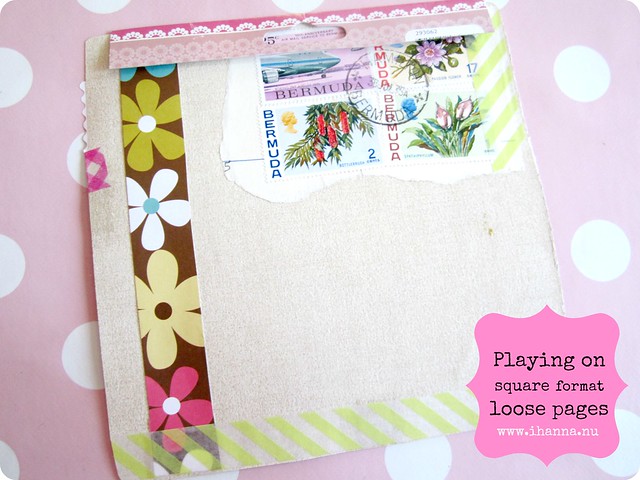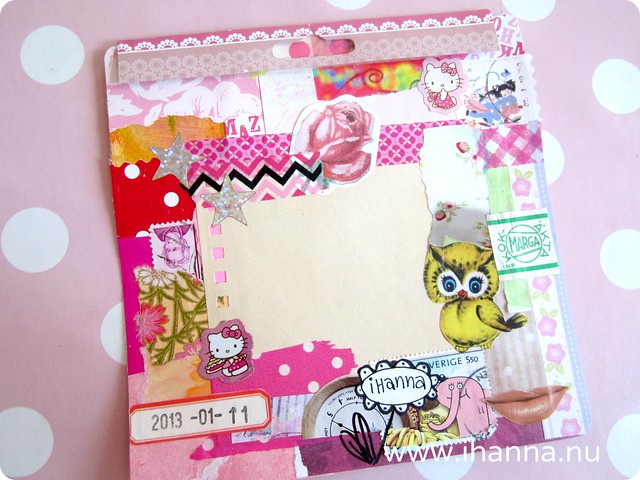Working on Loose Art Journal Pages
When I started art journaling I used spiral bound books found in the book shop. Loved those journals! Then I moved on to altering vintage books, something that I still love. The way I fill a page varies with day form, and on book binding technique, page format and paper structure in the book that I’m currently using.
Then I learned how to bind my own books which is time consuming but super fun. I so love filling my own handmade books!
In all that time I never thought I’d enjoy working in an art journaling way on loose pages, even though I have seen that others do that all the time. I thought I’d be loosing the whole idea of art journaling – the chronology, the possibility to turn the page, to move on, the documentation aspect… but things change, and so does my taste!
Last year when in a rut I cut out square pages for a spiral bound journal, but instead of binding it together at once I filled some of the pages before binding them. And I loved it!
Loooove loose page art journaling right now! Who would’ve thought?
I love the freedom of it! I love that I can pick any kind of paper, at any time. That I can start 10 pages and not finish any of them. That I can decide what order they will appear later. That I don’t have to include certain pages if I don’t like it later, or don’t want to (though I keep almost everything).
Love that I can include a postcard in between pages when I do bind the finished book pages together. That I can fill the page all the way to each edge and then punch through it with the binder machine! Like this page:
If you want to try it, I suggest you decide on a format and pre-cut a couple of pages to keep close at your desk. Then grab one and start filling first one side, then the other and see how you feel about it. Paint, glue, write, cut, play!
Have fun!
I’m going to show you the finished cover + spread of my own Smart Journal volume 1 too. But first let me know, have you tried working on loose pages? How did it work for you?




I’m always thinking about the format of my journals, and as opposed to you, I really don’t like spiral notebooks, because I can never flip the pages properly! I normally use my own stitched notebooks, or store bought ones, or altered books. I’m always thinking about loose pages, because I, too, read about people using them all the time, but somehow I think I still need the “notebook” framework, can’t really say why. Maybe sometime…:-)
Hagit, thanks for the input. I didn’t push to try loose pages, it just “came to me” as inspiration and then I really liked it. You shouldn’t do things just because others do it – but to push yourself out of your comfort zone out of curiosity is good. To try new things is really really good for creativity. :-)
You forgot to mention how easy it is to machine-stitch on loose pages – I am always at war with my book + sewing machine. My first ‘chronicles’ was made on loose pages and I want to go back to that some day, problem is, I just LOVE to bind books and to have a ‘book’ to work in.
Marit, yes you’vet got a good point there. Machine stitching on paper is super fun! When I made a travel journal I did a lot of that on the pages pre-binding and finishing the pages, so when you make your own books you can always stitch on the pages before binding them – or stitch bits of this and that that you then glue into the journal, right? :-)
I also just began a loose paper journal. But I put the papers in a binder (A5) because I missed the idea of having a real journal. I like to browse it!
For me it’s also a good way to work in the past if I want.
The thing I stil have to find out is : will I leave my papers in a two hole binder or will I bind them with my O-wire (but I think they are to small), maybe I have to buy a zutter. Ideas are welcome!
Sophie, if you’re happy with storing them in a binder I think you could keep it like that because it’s so easy and quick (and art journaling shouldn’t be complicated). But you could also sew them together in all kinds of way and add a hardcover later when you have enough pages for a book. Fun that you’re experimenting!
Your pages are fun and beautiful! I love this idea, but I know I will work both sides of the page and bind them later…maybe leave a slight margin at the edge…thinking, thinking, thinking…
Thanks for your kind comment Barbara! I love working on both sides and always plan for where the margin will go (no writing near that edge), but also enjoy that I can fill the whole page with collage and know the spiral binding will go on top of that. No blank page showing (and I love that!). :-)
Idea: keep a whole punched page separate and use it as a guide when filling the pages, in that way you know where the margins will go and how much space it will use up.
It’s also easier to gelli print on loose pages! Personally I feel more confident using loose pages, a bound book still intimidates me.
Kaz, I use a lot of papers in my journals. In the bound books I glue background pages in, so that could work for gelli prints to, right?
Do you bind your loose pages later or keep them “on the loose”?
Hanna, I am so sorry I’m so late seeing what you’ve been up to!
YES! I am working on loose pages since last fall! I am doing it with Bonnie of somepinkflowers, and you are so right! I pick out whatever I want to do it on, I change it up, some are not finished, some are big some are small. It is very freeing, and it’s also a great source of mystery as to what it will finally look like when I decide what order to put the pages in! Or, no order at all!
I just started doing that this year because I got tired of not finding the right book. I story my pages in a very artsy binder that I found but I may bind them later into a book, when the year is finished. I likle the freedom it gives me, but if I am completely honest, it doesn’t feel like a journal, it feels more like an art book. I hope to get used to it soon.